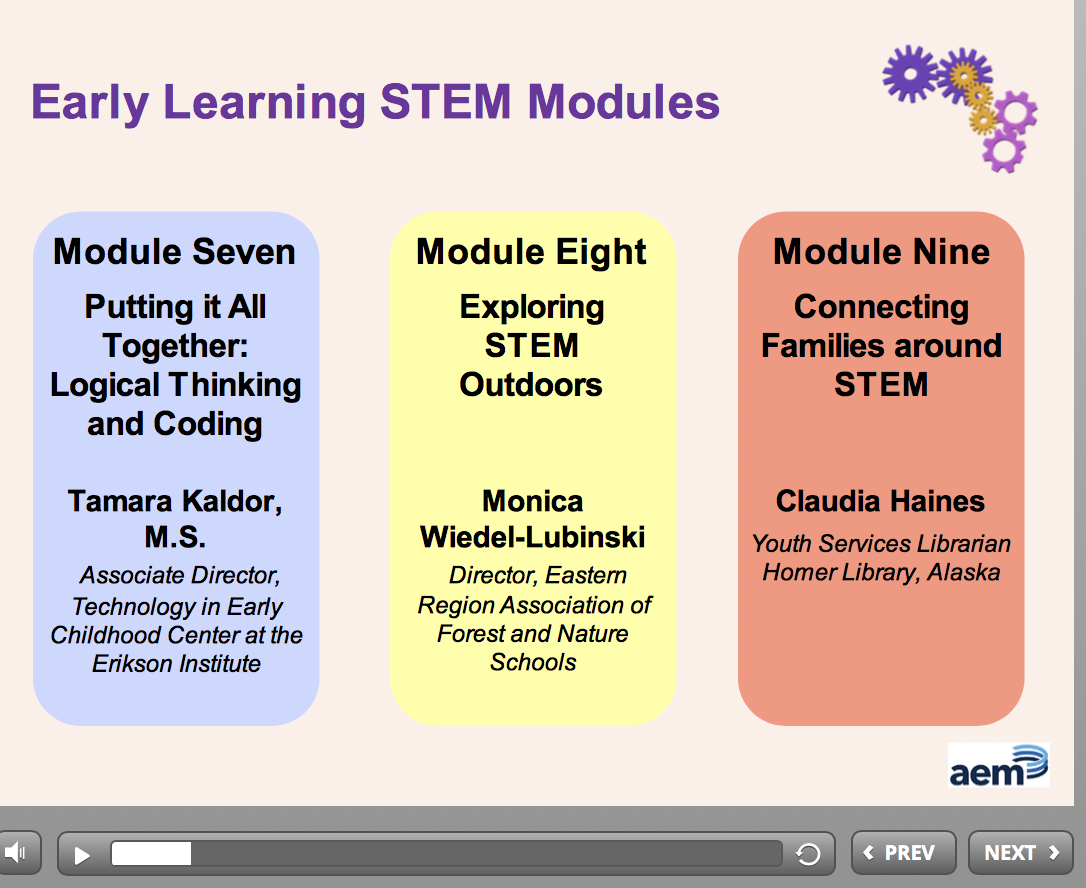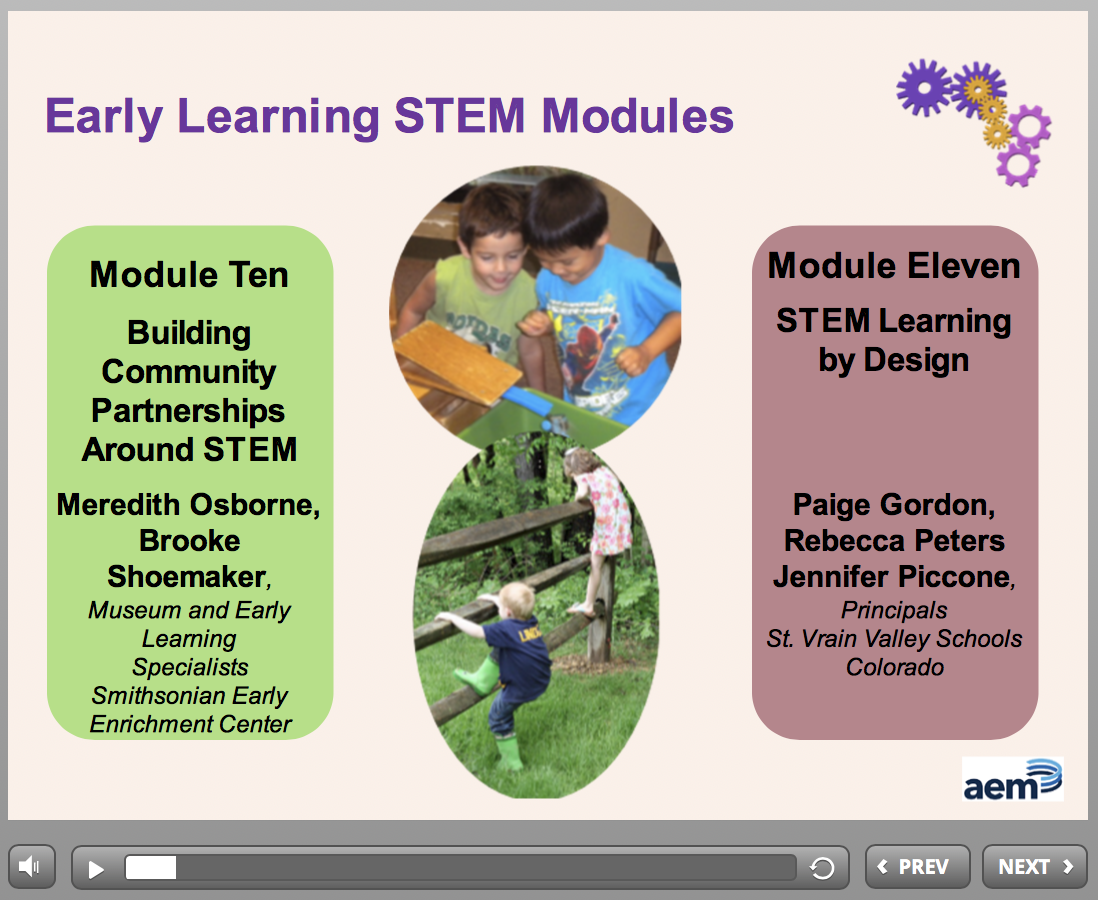Learning through online presentations: STEM in 11 parts
By Peggy Ashbrook
Posted on 2018-05-27
How does online learning through watching a webinar work for you? I am most engaged when I am able to participate in a live session where presenters might respond directly to my typed questions. But that means I have to be online at a set time so I often view the archived versions. Recorded sessions are more fun for me when I view with a colleague as we exclaim over insights, and I learn more when we discuss how the strategies might work in our programs. Program administrators support fun and effective use of webinars when they plan time for a group to view and work together.
 The Science, Technology, Engineering, and Mathematics (STEM) in Early Learning Series by the Preschool Development Grants of the US. Department of Education offers “research, practical application for classroom and home and provides examples of experiences that build scientific, technology, engineering, and mathematical learning for older toddlers and preschool children.” This 11-part series has two key objectives:
The Science, Technology, Engineering, and Mathematics (STEM) in Early Learning Series by the Preschool Development Grants of the US. Department of Education offers “research, practical application for classroom and home and provides examples of experiences that build scientific, technology, engineering, and mathematical learning for older toddlers and preschool children.” This 11-part series has two key objectives:
- Provide early childhood professionals with background information and research on science, technology, engineering, and mathematics (STEM) learning for young children.
- Provide evidence-based strategies to support STEM learning in varied environments, including early learning settings, homes, and community settings such as museums and libraries.
Each of the 11 part sessions of the series has hands-on work and discussion questions for participants, with supporting documents to print and use during each session.
|
MODULE |
PRESENTER |
TITLE |
|
Module One |
Debbie Leslie Senior Curriculum Developer, Director of Early Childhood Initiatives, UChicago STEM Education at the University of Chicago |
Introduction to STEM for Young Learners This introductory session will define STEM and the way in which young children learn the concepts and practices of science, technology, engineering and mathematics through an integrated approach. The presentation will describe academic vs intellectual learning and how STEM both builds and uses higher order thinking for concept development. The module will highlight research on early STEM learning’s impact on all children’s attitudes and readiness for school and lifelong success. |
|
Module Two |
Cindy Hoisington Early childhood science educator and curriculum developer, Education Development Center, Inc., Waltham, MA |
Creating Environments that Promote STEM Learning STEM teaching in early childhood settings begins with the environment. This module will focus on creating a learning environment that supports exploration, investigation, and problem-solving throughout the day and during long-term STEM investigations. It will address how the physical environment (spaces, materials, and displays) as well as the “three-dimensional environment” (the schedule and daily routines) can be arranged to promote children’s STEM thinking and learning. The important role of the teacher in creating and maintaining “a culture of inquiry” will be emphasized. |
|
Module Three STEM |
Peggy Ashbrook Early childhood science teacher, author, NSTA Early Years columnist and blogger |
Science in Early Learning Environments Module Three will focus on supporting science learning in early learning environments. The key principles that guide science learning, detailed in the National Science Teacher Association’s Position Statement on Early Childhood Science Education, will be described. Teachers’ understanding of how science occurs naturally within the learning environment and is enhanced by teachers’ intentional interactions, will be addressed. Specific examples of science experiences will be shared that demonstrate how science is integrated within other domains of learning and throughout the other S-T-E-M content areas. |
|
Module Four STEM |
Roberta Schomburg, Ph.D. Professor Emerita, Carlow University; Child Development Consultant, The Fred Rogers Company |
Technology in Early Learning Environments Technology is a way of doing. This module will begin with a review of simple technological learning such as the use of tools for exploring, collecting, and recording data and for solving problems and then delve into the use of technology and interactive media in formal learning settings to extend human senses and time limitations, support data collection and collaboration, and facilitate communicating evidence, claims, and design solutions. The NAEYC Position Statement: Technology and Interactive Media as Tools in Early Childhood Programs Serving Children from Birth through Age 8 and the US Department of Education’s Early Learning and Educational Technology Policy Brief will be addressed. |
|
Module Five STEM |
Beth Dykstra VanMeeteren Associate Professor, Director of the Iowa Regents’ Center for Early Developmental Education |
Engineering in Early Learning Environments This module will define engineering [concepts, practices, and habits of mind] and how it links to other domains of learning. It will focus on helping professionals identify where opportunities for engineering instruction exist in early childhood settings and how they join with other S-T-E-M content to support children’s learning. |
|
Module Six STEM |
Lisa Ginet, Ed.D. Director, Early Math Collaborative, Erikson Institute |
Mathematics in Early Learning Environments Module Six will introduce big ideas of early mathematics, explore children’s mathematical development, and discuss strategies for designing routines, activities, and environments that foster children’s math thinking and problem-solving. . It will also focus on strategies to support early learning professionals’ understanding of how early math relates to other disciplines. |
|
Module Seven |
Tamara Kaldor, M.S. Associate Director, Technology in Early Childhood Center at the Erikson Institute |
Putting it All Together: Logical Thinking and Early Coding Coding and higher order, or abstract, thinking skills evolve in the context of children’s play and interactions with peers and adults and go hand-in-hand with problem solving and reasoning. This module will help teachers examine strategies for extending children’s learning experiences by planting the seeds of computational or logical thinking in indoor and outdoor settings. |
|
Module Eight |
Monica Wiedel-Lubinski Director, Eastern Regional Association of Forest and Nature Schools |
Exploring STEM Outdoors Playgrounds and outdoor play areas offer rich opportunities for STEM learning. Module Eight expands teachers’ thinking about the benefits of nature-based learning and outdoor play. The module will examine the connections between nature and basic STEM skills including inquiry, observation, and experimentation. Participants will consider outdoor learning strategies and the teacher’s role as a facilitator of STEM-rich outdoor experiences. |
|
Module Nine |
Claudia Haines Youth Services Librarian Homer Library, Alaska |
Connecting Families Around STEM As their children’s first teachers, parents and caregivers play a vital and positive role in the STEM (and STEAM) education of young children. This module will introduce strategies for engaging families in the development of children’s STEM skills. It will offer suggestions for parenting education activities as well as a variety of inclusive techniques to partner with families to recognize the informal ways in which they can support children’s STEM learning at school, at home, and in their community. |
|
Module Ten |
Meredith Osborne & Brooke Shoemaker Museum and Early Learning Specialists Smithsonian Early Enrichment Center |
Building Community Partnerships Around STEM Science, technology, engineering and mathematics (STEM) learning occurs beyond the formal early learning setting. Early childhood professionals can partner with museums, libraries, community gardens, and more to connect children and their families to these informal learning opportunities. Module Ten will discuss ways intellectual learning can be facilitated in different settings and provide techniques for bringing STEM learning outside of the classroom. |
|
Module Eleven |
Paige Gordon, Jennifer Piccone, and Becky Peters Principals, St. Vrain Valley Schools Colorado, |
STEM and Design Thinking in the Preschool Classroom Module Eleven will demonstrate design thinking in a preschool setting. Principals from St. Vrain Valley Schools (Colorado) will describe the opportunities and benefits of developing design thinking and STEM challenges in preschool classrooms and provide authentic examples of design thinking in action. |
From the first to the eleventh module you will see children using technologies (see examples on slide 1.15 in Module 4) in STEM (science, engineering, and math) learning situations. You will gather information about integrated S-T-E-M learning strategies and curriculum that other educators are developing based on research and find useful strategies for your teaching environment. Indoors, outdoors, in a library and at a museum, STEM is more than an acronym! Here are just a few of my favorite snippets from the eleven modules:
See slides 1.36-1.38 in Module 2: Creating Environments That Promote STEM Learning presented by Cindy Hoisington and do the exercise of examining photos of “Science Centers” to see if they are accessible, inviting, and engaging so children will want to do sustained work with the materials.
 Check out the Activities and Handouts for the modules. Questions such as, “What are intentional strategies you use to promote habits of mind in the block, housekeeping and art areas?” and “How do you support children’s systems thinking, creativity, optimism, collaboration, communication and attention to ethical considerations?” from Module 5: Engineering in Early Learning Environments presented by Beth Van Meeteren, help us engage with the ideas and consider our own practice.
Check out the Activities and Handouts for the modules. Questions such as, “What are intentional strategies you use to promote habits of mind in the block, housekeeping and art areas?” and “How do you support children’s systems thinking, creativity, optimism, collaboration, communication and attention to ethical considerations?” from Module 5: Engineering in Early Learning Environments presented by Beth Van Meeteren, help us engage with the ideas and consider our own practice.
The importance of family engagement is addressed in Module 9, presented by Claudia Haines: “Parents and caregivers, their children’s first teachers, are a vital part of children’s lives, regardless of their race, background, socio-economic status. Children are more confident and successful learners when parents and caregivers are involved.” Family fort night at the library is one example of a family engagement event. Growing relationships with families develop through learning about and integrating families’ and caregivers’ interests, strengths, and knowledge into their children’s learning. Another key strategy is to educate adults. “Adult programs…are designed to give adults time to learn and play in low pressure situations without the expectation of teaching and guiding their kids at the same time.” See slide 1.20 to learn about communication tools that will help you meet families where they are.
This set of modules is not a brief overview STEM but a thorough walk into STEM learning with activities for adult learners. There are explanations that help us understand the practices of science and engineering, like this description of a graphic design image used by a program to describe a design process: “Even though it looks like a linear process, it’s really important to note that design is really a very messy, organic, cyclical process that really must ebb and flow in order to be successful.” Paige Gordon, Module 11: STEM and Design Thinking in the Preschool Classroom.
Find your webinar buddy to watch and do the activities together, or use the Facilitator Toolkit to present these sessions for your program. Already a “STEM” expert? Download the resources to expand your own. Then visit the NSTA Learning Center and search for “STEM” in the elementary resources, and check “Type/Format” to find additional online learning presentations such as, “STEM Starts Early: Guidance and support from the NSTA Early Childhood Science Education Position Statement,” a 90-minute webinar archived from April 15, 2015. And add resources you find helpful in a comment below!
Disclaimer: The views expressed in this blog post are those of the author(s) and do not necessarily reflect the official position of the National Science Teaching Association (NSTA).




